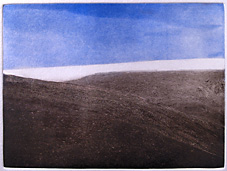The Three Peaks of the Phoenix, a range midway between Fuji-san and Japan’s second-highest mountain Kita-dake, offer incomparable views to either side. At sunrise Fuji-san appears red for about 10 minutes, and the early light on Kita-dake opposite warms that formidable mass of rock. The mist on distant peaks gives a sense of unlimited vistas. As the day brightens, Yatsugatake (Eight Peaks) with its distinctive 3000-meter high Aka-dake (Red Peak), and Yarigadake, become visible, bringing memories of other ascents.

Takushi-dake summit
The Asian phoenix and the Arabian-Egyptian phoenix are not really birds of a feather — more like distant cousins. The Arabian-Egyptian phoenix rises every half-millennium from the ashes of its own pyre, a resurrection myth that informs Christian lore and inspires hopes of triumph over adversity. It appears as a double-headed eagle in European heraldry and coinage, and as the Firebird of Russian and Slavic lore involving heroic quests. Stravinsky made wonderful use of the legend in his Firebird Suite.
The Asian phoenix, like its distant cousin, is also associated with the sun and with ascent toward the light, a feeling we can readily appreciate among the brightly lit rock outcroppings of these three peaks. But the Japanese version, having been introduced during the Asuka Period (7th century) from China, is more of a Yin/Yang creature, an embodiment of both harmony and conflict. As such it is both an Imperial and a marital symbol. Its best-known Imperial incarnation in Japan is atop the Byodoin in Uji, between Nara and Kyoto. The kanji 鳳 凰 mean male and female phoenix.

Winged Fuji
Each of the Three Peaks of the Phoenix represents an aspect of the Buddha, personified by a deity with specific responsibilities for our welfare. First up (if arriving by train to Kofu) is Yakushi-dake (薬師岳), for health. It has a marvelous natural rock-garden which looks like the artifact of some primordial civilization. Then Kannon-dake (観音岳), the highest of the three at 2840 meters, the Goddess of Mercy. The way its forms fit together seems to have, instead of the usual craggy rock-face, a feminine grace. From there a narrow ridge leads to Jizo-dake (地蔵岳), the god of travelers. This is one of the most distinctive peaks in the entire Japanese Alps, and the one Walter Weston chose for his frist ascent, sparking Japanese interest in mountaineering in the early 20th century. So, there you have it — health, compassion, and safe travels. What more could one wish for.

